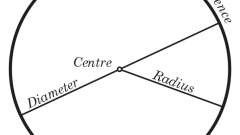Instruction
1
Analytically the circumference is given by equation of the form (x-x0)2+(y-y0)2=R2 where x0 and y0 are the coordinates of the center of the circle, R is its radius. Thus, the center of the circle (x0;y0) here explicitly.
2
Example. Set the center of the figure defined in the Cartesian coordinate system by the equation (x-2)2+(y-5)2=25.Solution. This equation is the equation of a circle. Its center has coordinates (2;5). The radius of such circle is equal to 5.
3
The equation x2+y2=R2 corresponds to a circle with centre at the origin, i.e., at the point (0;0). The equation (x-x0)2+y2=R2 means that the center of the circle has coordinates (x0;0) and lies on the x-axis. The equation in the form x2+(y-y0)2=R2 says about the location of centre with coordinates (0;y0) on the y-axis.
4
The General equation of a circle in analytic geometry will be written as: x2+y2+Ax+By+C=0. To bring this equation to the abovementioned in mind, it is necessary to group members and allocate full squares: [x2+2(A/2)x+(A/2)2]+[y2+2(B/2)y+(B/2)2]+C-(A/2)2-(B/2)2=0. To highlight the full squares, as you can see, you need to add additional quantities: (A/2)2 and (B/2)2. Below the equal sign is preserved, the same value should be deducted. The addition and subtraction of the same number does not alter the equation.
5
Thus: [x+(A/2)]2+[y+(B/2)]2=(A/2)2+(B/2)2. From this equation it is clear that x0=-A/2, y0=-B/2, R=√[(A/2)2+(B/2)2-C]. By the way, the expression for the radius can be simplified. Comnote both sides of R=√[(A/2)2+(B/2)2-C] 2. Then: 2R=√[A2+B2-4C]. Hence R=1/2·√[A2+B2-4C].
6
A circle cannot be the graph of a function in Cartesian coordinates, since, by definition, in a function, each x corresponds to only one y value, and the circumference of these Millennials will be two. To see this, swipe perpendicular to the axis Ox intersecting the circle. You will see that the points of intersection of the two.
7
But the circle can be represented as the Union of two functions: y=y0±√[R2-(x-x0)2]. Here x0 and y0, respectively, represent the desired coordinates of the center of the circle. The coincidence of the center of the circle with the origin the Union of the functions takes the form: y=√[R2-x2].
Note
Two circles having the center point with the same coordinates, are called concentric. If they are given by the equations (x-x0)2+(y-y0)2=R2 and (x-x0')2+(y-y0')2=R'2, then x0=x0', y0=y0'. In the General equation for a concentric circle A1=A2 and B1=B2.
Useful advice
By the way, in physics, a circle can be considered as a thin uniform ring. The center of this ring will be the center of mass (or centre of inertia) of the body. If the ring has mass m and radius r, through centre, perpendicular to the plane of the ring to hold the axle, the moment of inertia of a ring concerning an axis is equal to mr2. The moment of inertia is fundamentally important when considering the rotational motion.


